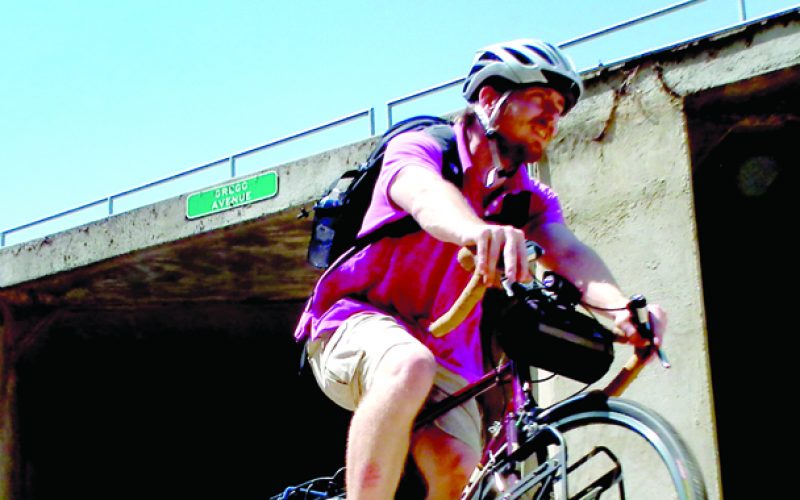By Terrah Baker
 It’s not easy taking on the 22-mile trail system that runs throughout the city of Fayetteville and grows each year. The master plan, created by Fayetteville engineers, lays out 100 miles of trails at about two to three miles completed each year.
It’s not easy taking on the 22-mile trail system that runs throughout the city of Fayetteville and grows each year. The master plan, created by Fayetteville engineers, lays out 100 miles of trails at about two to three miles completed each year.
This plan and the trail system was created for one main purpose — to provide an alternative system of transportation that would connect riders to destinations throughout the city and beyond.
The Free Weekly talked with several local experts who helped navigate the trail system, and pinpoint the reasons why so many Northwest Arkansans have taken up bicycling as a lifestyle and a fast way to get around town.
The Trail System

Staff Photo Terrah Baker: Michael Whitehead parks his bicycle at a designated bike parking area near The Union on the University of Arkansas campus.
In 2003, Fayetteville adopted the Alternative Transportation and Trail Master Plan. Nine years later, about
22 miles of finished trail means the city is right on track for completion. And those 22 miles don’t include the small trails like Gulley Park Trail that loop around parks and recreational areas.
The next big step was in late 2005 when the city established a nine-person in-house construction team, whose sole purpose was, and is, to build and maintain the trails.
Fayetteville trail engineers and construction crew work to make the trails accessible, safe and approachable by the average rider going from home to school or work.
Aligning the trails with creek beds is one way they designed the trail flatter, and made it easier to ride.
“It’s definitely a conscious effort. It can’t be so hard that people can’t use it,” said Matt Mihalevich, trails coordinator for Fayetteville.
Right now the trail runs mostly north and south parallel to College Avenue/U.S. 71-B, north past the Northwest Arkansas Mall to Lake Fayetteville, and south to Martin Luther King next to the University of Arkansas. Eventually, the trails team will take on the project of constructing over Mount Sequoyah on the east side of Fayetteville, but for now they’re concentrating on the trails they feel will get the most use.
The 36-mile Razorback Regional Transit system of trails, leading from Fayetteville to Bentonville, is projected to be complete by the end of 2013, giving trail goers even more options for destinations.
Bikes On Campus
 Luckily, having a bike on campus has never been as convenient or beneficial as the school population grows and the traffic throughout the city gets more congested. University officials have attempted to create this bike-friendly environment by implementing several programs.
Luckily, having a bike on campus has never been as convenient or beneficial as the school population grows and the traffic throughout the city gets more congested. University officials have attempted to create this bike-friendly environment by implementing several programs.
Registering bikes with the Parking and Transit Office on campus was originally a way for university officials to know how many bikes were on campus, to help in the aid of recovering lost or stolen bikes and to issue warnings and tickets for locking a bike to unauthorized locations.
In an attempt to make it easy to find bike loops — authorized locations for parking bicycles on campus — they created the campus map available on any smartphone. Along with showing bus routes and schedules, it allows students to find the bike loop nearest to their current location.
Since the three years the registration program has been in place, 1,503 bikes have been registered, with more than
150 bike loops installed. Over the 12 years Jennifer Hazelrigs, assistant director for the University Recreation Office, said she’s been at the university, she has seen an increase in the number of bikes on campus.
“With the small streets and increase of students, and the time they have to go from class to class, [biking] is just faster, more convenient and less stressful,” she said.
From campus, the trail system is most easily accessible from Frisco Trail, Oakridge Trail and soon Garland once the bike lanes are completed in late 2013. Frisco is located down Maple Street next to Carnall Hall, and Oakridge southwest of Dickson Street from campus.
A Lifestyle
The American Heart Association reported in early 2012 that 34 percent of the U.S. population is not just overweight, but obese, and that number has grown from previous years. They report that nearly 50 percent of U.S. adults and 65 percent of adolescents do not currently get the recommended amount of physical activity each day.
Compounding the health issues, many communities overlook the effects of transportation methods on health, and plan based on a reliance of motorized vehicles. Luckily, Fayetteville is not one of those communities, explained chair of the Bicycle Coalition of the Ozarks, Laura Kelly.
To her, riding a bike to work is a “quality of life issue,” and the benefits are proven by science. A study at the University of Copenhagen, and then endorsed by the AHA, showed employees who rode their bike to work were more likely to be on time, satisfied with their lives and even more productive.
“On a physiological level, it gets my blood going and releases endorphins. Exercise is addicting for a reason, and when I arrive at my destination I feel productive,” Kelly said.
She said most of the fear felt about biking is perceived fear -— not wanting to block traffic or get hit by a car. But what the studies show are bicycle commuters are 30 times less likely of dying (mainly from health risks like heart disease and diabetes) than those who drive cars.
While busy lives don’t allow most people to get their recommended dose of exercise each day, for Kelly, biking allows her to stay healthy and have an economical mode of transportation.
Cost Savings
Scott Schroen owns Phat Tire Bike Shop in Fayetteville and Bentonville, and explained how biking doesn’t have to slow you down, and can save money. When driving in town on a relatively flat area, a bike can reach up to 22 miles per hour, he said.
Combine that with no traffic lights, hardly any stop signs and no reason to stop unless you come to an intersection, bikers can arrive “a lot of times only a little bit later than a car would,” Schroen explained.
“But there’s barely any wear and tear on the bike. You’re not paying for gas, insurance, parking and you arrive at the front door of where you’re going, you combine all of those together, a bike just blows away a car coffin any day,” he said.
The Bureau of Labor Statistics reported this year that Americans are spending about 17 percent of their income on transportation costs.
Schroen suggests pumping up tires regularly — how often depends on the type of bike — and getting a standard tune up whenever the bike begins to be heard (chains rattling, tires squeaking). But overall, a bike can save riders hundreds of dollars a month.
Laws in Arkansas
In Arkansas, Kelly said, it’s important to keep up with laws pertaining to bicyclists. And it’s not hard since there’s only one. The bicycle-specific law states that cars passing a bicycle must allow 3 feet of clearance.
Overall, the vehicle code states that bicyclists must behave like drivers of a vehicle. That means stopping at stoplights, stop signs and somehow letting other drivers know when you’re turning. It also says that drivers must realize and be aware that there may be times bicycles need to take up the whole lane for riding. Kelly said use this law when riding on a road with no side or bike lanes for short periods of time.
Locally, Mihalevich said the new traffic light on North Street and Skull Creek Trail is a good place to start implementing the law. It now acts as a stoplight for both the trail goers and car drivers. Many bikers will cross if there is no traffic, despite the color of the light, but he said that’s a dangerous decision.
“If they got hit or anything they’re completely at fault,” he said.
When all of the information is analyzed, utilizing the trail system resource seems like an enjoyable — and maybe even more beneficial — way to get off campus.
“I think about who really enjoys driving in town? It’s not that great. When I can ride somewhere, even if it’s a long ride, I can enjoy it. It’s a pace my mind can comprehend,” Kelly said.










